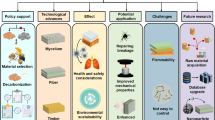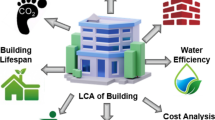Abstract
Purpose
The main aim of the study is to assess the environmental and economic impacts of the lodging sector located in the Himalayan region of Nepal, from a life cycle perspective. The assessment should support decision making in technology and material selection for minimal environmental and economic burden in future construction projects.
Methods
The study consists of the life cycle assessment and life cycle costing of lodging in three building types: traditional, semi-modern and modern. The life cycle stages under analysis include raw material acquisition, manufacturing, construction, use, maintenance and material replacement. The study includes a sensitivity analysis focusing on the lifespan of buildings, occupancy rate and discount and inflation rates. The functional unit was formulated as the ‘Lodging of one additional guest per night’, and the time horizon is 50 years of building lifespan. Both primary and secondary data were used in the life cycle inventory.
Results and discussion
The modern building has the highest global warming potential (kg CO2-eq) as well as higher costs over 50 years of building lifespan. The results show that the use stage is responsible for the largest share of environmental impacts and costs, which are related to energy use for different household activities. The use of commercial materials in the modern building, which have to be transported mostly from the capital in the buildings, makes the higher GWP in the construction and replacement stages. Furthermore, a breakdown of the building components shows that the roof and wall of the building are the largest contributors to the production-related environmental impact.
Conclusions
The findings suggest that the main improvement opportunities in the lodging sector lie in the reduction of impacts on the use stage and in the choice of materials for wall and roof.








Similar content being viewed by others
References
Adhikari R (1987) Estimation of economic discount rate for practical project appraisal: the case of Nepal. Proj Apprais 2:113–122
Asdrubali F, Baldassarri C, Fthenakis V (2013) Life cycle analysis in the construction sector: guiding the optimization of conventional Italian buildings. Energy Build 64:73–89
Asif M, Muneer T, Kelley R (2007) Life cycle assessment: a case study of a dwelling home in Scotland. Build Environ 42:1391–1394
ATD Home Inspection (2015) Average life span of Homes, applicances, and mechanicals. http://www.atdhomeinspection.com/advice/average-product-life. Accessed 23 May 2015
Becken S, Frampton C, Simmons D (2001) Energy consumption patterns in the accommodation sector—the New Zealand case. Ecol Econ 39:371–386
Bhattacharya SC, Salam AP (2002) Low greenhouse gas biomass options for cooking in the developing countries. Biomass Bioenerg 22:305–317
Bhochhibhoya S, Cavalli R (2016) Global warming assessment of Himalayan buildings. In: Balkau F, Massari S, Sonnemann G (eds) Life cycle approaches to sustainable regional development. Taylor & Francis/Routledge
Brown KL, Greer DC, Schwegler B (2011) Life cycle management approach to the design of large-scale resorts. Towar Life Cycle Sustain Manag. doi:10.1007/978-94-007-1899-9_22
Chen GQ, Chen H, Chen ZM et al (2011) Low-carbon building assessment and multi-scale input–output analysis. Commun Nonlinear Sci Numer Simul 16:583–595
Chenoweth J (2009) Is tourism with a low impact on climate possible? In: Worldwide hospitality and tourism themes, pp 274–287
Cuéllar-Franca RM, Azapagic A (2012) Environmental impacts of the UK residential sector: life cycle assessment of houses. Build Environ 54:86–99
Ferreira J, Duarte Pinheiro M, de Brito J (2015) Economic and environmental savings of structural buildings refurbishment with demolition and reconstruction-a Portuguese benchmarking. J Build Eng 3:114–126
Filimonau V, Dickinson J, Robbins D, Huijbregts MAJ (2011) Reviewing the carbon footprint analysis of hotels: life cycle energy analysis (LCEA) as a holistic method for carbon impact appraisal of tourist accommodation. J Clean Prod 19:1917–1930
Frischknecht R, Editors NJ, Althaus H, et al (2007) Overview and methodology ecoinvent report. No. 1. 77
Frischknecht R, Jungbluth N, Althaus H-J et al (2004) The ecoinvent database: overview and methodological framework (7 pp). Int J Life Cycle Assess 10:3–9
Gentle P, Maraseni TN (2012) Climate change, poverty and livelihoods: adaptation practices by rural mountain communities in Nepal. Environ Sci Pol 21:24–34
Gluch P, Baumann H (2003) The life cycle costing (LCC) approach : a conceptual discussion of its usefulness for environmental decision-making. Build Environ 39:571–580
Gu L, Lin B, Zhu Y et al (2008) Integrated assessment method for building life cycle environmental and economic performance. Build Simul 1:169–177
IPCC (2013) Climate change 2013: the physical science basis. In: Stocker TF, Qin D, Plattner GK, Tignor M, Allen SK, Boschung J, Nauels A, Xia Y, Bex V, Midgley PM (eds) Contribution of Working Group I to the Fifth Assessment Report of the Intergovernmental Panel on Climate Change. Cambridge University Press, Cambridge, United Kingdom and New York, NY, USA, p 1535
Khasreen MM, Banfill PFG, Menzies GF (2009) Life-cycle assessment and the environmental impact of buildings: a review. Sustainability 1:674–701
Kirk SJ, Dell’Isola AJ (1995) Life cycle costing for design professionals. Mc Graw-Hill, New York
Knauf M (2015) Applying opportunity costs to correctly interpret resource efficiency in LCA studies and environmental product declarations. Eur J Wood Wood Prod 73:251–257
Little MA, Hanna JM (1978) Responses of high-altitude populations to cold and other stresses, 1st edn. The syndics of Cambridge University Press, Cambridge
Mearig T, Coffee N, Morgan M (1999) Life Cycle Cost Analysis Handbook
Moschetti R, Mazzarella L, Nord N (2015) An overall methodology to define reference values for building sustainability parameters. Energy Build 88:413–427
Nepal Oil Corporation Limited (2015) Retail selling price based on Kathmandu
Ortiz O, Castells F, Sonnemann G (2009) Sustainability in the construction industry: a review of recent developments based on LCA. Constr Build Mater 23:28–39
Pandit M (2013) The Himalayas must be protected. Int Weekely J Sci 501:283
Pittet D, Jagadish KS, Kotak T et al (2012) Environmental impact of building technologies: a comparative study in Kutch District, Gujarat state, India, 1st edn. Springer, Paris
Pokharel MR, Parajuli BK (2000) Retrofitting traditional buildings by passive solar concepts in Jumla and Solukhubu, 1st edn. International Centre for Integrated Mountain Development, Kathmandu
Pouliotte J, Smit B, Westerhoff L (2009) Adaptation and development: livelihoods and climate change in Subarnabad, Bangladesh. Clim Dev 1:31–46
Rathcliffe J, Stubbs M (2005) Urban planning and real estate development, 2nd edn. The Natural and Built Environment Series, Taylor and Francis
Raymond J, Cole ES (2000) Reconciling theory and practice of life-cycle costing. Build Res Inf 28:368–375
Ristimäki M, Säynäjoki A, Heinonen J, Junnila S (2013) Combining life cycle costing and life cycle assessment for an analysis of a new residential district energy system design. Energy 63:168–179
Scheuer C, Keoleian GA, Reppe P (2003) Life cycle energy and environmental performance of a new university building: modeling challenges and design implications. Energy Build 35:1049–1064
Seebach D, Adell A, Tepper P (2011) ENG_SMART_SPP_LCC_CO2_tool_v2
Sonnemann G, Castells F, Schuhmacher G (2003) Integrated life–cycle and risk assessment for industrial processes. Advanced methods in resource and waste management series, Volume 2. Advanced Methods in Reserouce and Waste Management, Lewis Publishers
Sterner E (2002) Green procurement of buildings estimation of environmental impact and life-cycle cost. Civ Min Eng Div Steel Struct PhD:185
UNEP (2009) Buildings and climate change: a summary for decision-makers. 15 Rue de Milan, 75441 Paris CEDEX 09, France
Weidema B, Bauer C, Hischier R et al (2013) Swiss Centre for Life Cycle Inventories overview and methodology (final)(v3)
World Bank (2015) Inflation, consumer prices (annual %). In: World Bank Gr. http://data.worldbank.org/indicator/FP.CPI.TOTL.ZG/countries/NP?display=graph. Accessed 20 Sep 2015
Zabalza Bribián I, Aranda Usón A, Scarpellini S (2009) Life cycle assessment in buildings: state-of-the-art and simplified LCA methodology as a complement for building certification. Build and Environ 44(12):2510–2520
Zhang W, Tan S, Lei Y, Wang S (2014) Life cycle assessment of a single-family residential building in Canada: a case study. Build Simul 7:429–438
Author information
Authors and Affiliations
Corresponding author
Additional information
Responsible editor: Pomthong Malakul
Electronic supplementary material
ESM 1
(DOCX 43 kb)
Rights and permissions
About this article
Cite this article
Bhochhibhoya, S., Pizzol, M., Achten, W.M.J. et al. Comparative life cycle assessment and life cycle costing of lodging in the Himalaya. Int J Life Cycle Assess 22, 1851–1863 (2017). https://doi.org/10.1007/s11367-016-1212-8
Received:
Accepted:
Published:
Issue Date:
DOI: https://doi.org/10.1007/s11367-016-1212-8




